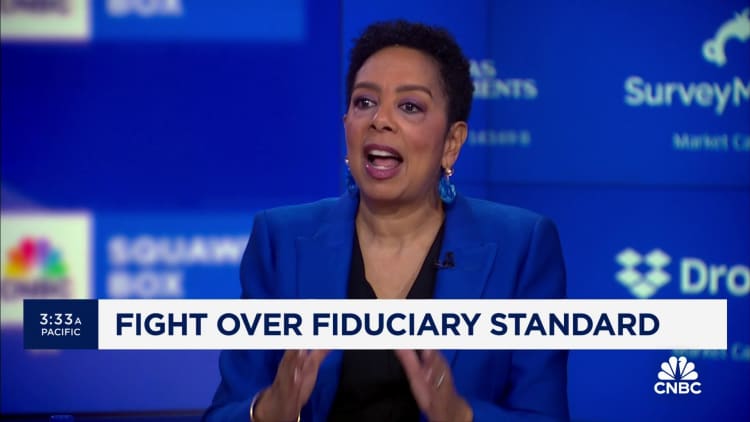Melkinimages | E+ | Getty Images
Target-date funds are a way for 401(k) participants to put their retirement savings on autopilot — and they capture the lion’s share of investor contributions to 401(k) plans.
About 29% of assets in the average 401(k) plan were held in TDFs as of 2023, according to the Plan Sponsor Council of America, a trade group. That share is the largest of any fund category, and is up from 16% in 2014, according to PSCA data.
By 2027, target-date funds will capture roughly 66% of all 401(k) contributions, and about 46% of total 401(k) assets will be in TDFs, according to a 2023 estimate by Cerulli Associates, a market research firm.
More from Personal Finance:
Biden signs bill to raise Social Security benefits for public workers
How to maximize your 401(k) plan in 2025
Time to tweak your investments after lofty stock returns
That popularity is largely due to employers’ broad adoption of TDFs as the default investment for workers who are automatically enrolled into their company 401(k) plan.
While the funds carry benefits for many investors, they may have drawbacks for others, financial advisors said.
“Target funds have a place for some investors, but they certainly aren’t and shouldn’t be used for everyone,” said Winnie Sun, managing partner of Sun Group Wealth Partners, based in Irvine, California, and a member of CNBC’s Financial Advisor Council.
How target-date funds work
Financial experts generally recommend investors de-risk their nest eggs as they age — typically by shifting from more aggressive (and volatile) holdings like stocks to more stable ones like bonds and cash.
TDFs do this automatically, based on an investor’s estimated year of retirement.
For example, a 35-year-old investor who expects to retire in 30 years would likely choose a 2055 fund. A 55-year-old may pick a 2025 fund. (The funds typically come in five-year increments.)
The fund’s asset allocation slowly becomes more conservative in the years leading up to, and sometimes after, that retirement year.
A one-stop shop for 401(k) savers
Advocates often laud the simplicity of TDFs, known as a one-stop shop for 401(k) savers who may not have the time or knowledge to adequately manage a custom portfolio.
“From where I sit, target-date funds have been nothing short of the biggest positive development for investors since the index fund,” Christine Benz, director of personal finance and retirement planning at Morningstar, wrote in June.
They take important decisions like asset allocation and investment selection “wholly out of investors’ hands,” Benz wrote.
TDFs amount to inexpensive and reasonable investment advice for people who may not be able to afford hiring an advisor and who may be prone to making “kooky” investment choices, she wrote. TDFs also discourage behavior known to erode investor returns, like buying high and selling low, she added.
“They’re designed to be easier-to-manage investments for those who just prefer simplicity and more convenience,” Sun said.
There may be drawbacks
However, there are some reasons why TDFs may not work for certain investors, especially those with ample savings outside their 401(k) plan or who want to take a more hands-on approach, advisors said.
For one, just because investors expect to retire around the same age doesn’t mean the same asset allocation is appropriate for each of them.
“What if you’re more conservative or instead prefer more growth, aggressive tech investing, or prefer to invest in socially responsible investments?” Sun said.
From where I sit, target-date funds have been nothing short of the biggest positive development for investors since the index fund.
Christine Benz
director of personal finance and retirement planning at Morningstar
Asset managers have different investment philosophies. Certain fund families may be more aggressive or conservative than others, for example.
Employers generally only offer TDFs from one financial company, and the funds that are offered may or may not align with an investor’s risk profile, experts said.
“It is important that a person understands how much risk they are taking in their target-date fund,” said Carolyn McClanahan, a certified financial planner and the founder of Life Planning Partners in Jacksonville, Florida.
“For example, you would think a 2030 target-date fund would be conservatively allocated, but most are 60% equities because they assume you’ll be drawing off those funds over a long period of time,” said McClanahan, a member of CNBC’s Advisor Council.
Investors may be able to build a less expensive portfolio on their own by using a mix of index funds, though this approach would take more work on investors’ part, she said.
Additionally, TDFs don’t allow for “tax location” of different assets, McClanahan said.
This aims to boost after-tax investment returns by strategically holding stocks and bonds in certain account types.
For example, assets with potential for high growth are well-suited for Roth accounts, since investment earnings are generally tax-free in retirement, said McClanahan.
Experts also generally recommend holding many bonds and bond funds in tax-deferred or tax-exempt accounts.
Despite shortcomings for certain investors, “do target-date funds help investors who are unaware of the basics of investing find their way to a sane investment mix given their life stage?” Benz wrote. “A thousand times yes.”


 Economics1 week ago
Economics1 week ago
 Personal Finance1 week ago
Personal Finance1 week ago
 Blog Post7 days ago
Blog Post7 days ago
 Economics6 days ago
Economics6 days ago
 Economics1 week ago
Economics1 week ago
 Economics1 week ago
Economics1 week ago
 Economics6 days ago
Economics6 days ago
 Economics1 week ago
Economics1 week ago













